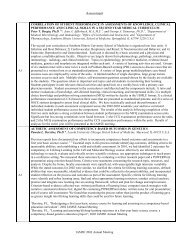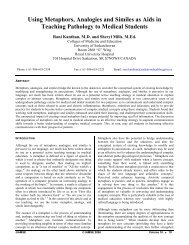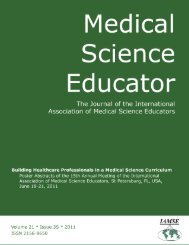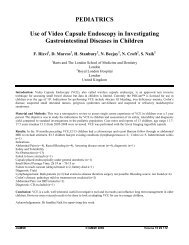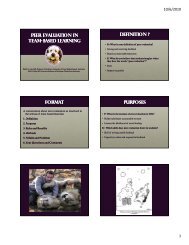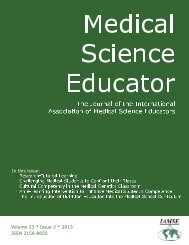Click here to view complete journal in pdf-format - IAMSE
Click here to view complete journal in pdf-format - IAMSE
Click here to view complete journal in pdf-format - IAMSE
You also want an ePaper? Increase the reach of your titles
YUMPU automatically turns print PDFs into web optimized ePapers that Google loves.
DISCUSSION<br />
We were pleased <strong>to</strong> f<strong>in</strong>d that the <strong>in</strong>corporation of<br />
this service-learn<strong>in</strong>g project was a beneficial<br />
experience for everyone <strong>in</strong>volved.<br />
Instructional Methods Abstract ID: 182 Award<br />
Nom<strong>in</strong>ee<br />
IMPLEMENTING A LAPAROSCOPIC<br />
SURGICAL SKILLS CURRICULUM INTO A<br />
SURGICAL RESIDENCY PROGRAM<br />
Dante Dali, MS3 1 , Jeff Maire, DO, FACOS 2 ., Adam<br />
Halverson, MS3 1 , Jason Arribas, MS3 1 , Amanda<br />
Eilers, DO 2 and Edward F<strong>in</strong>nerty, PhD1 1 Des<br />
Mo<strong>in</strong>es University and 2 Mercy Surgical Affiliates,<br />
Des Mo<strong>in</strong>es, IA, USA<br />
PURPOSE<br />
Simulation exercises are <strong>in</strong>creas<strong>in</strong>gly be<strong>in</strong>g used for<br />
teach<strong>in</strong>g and assess<strong>in</strong>g surgical skills, yet little has<br />
been reported on how these experiences translate<br />
<strong>in</strong><strong>to</strong> operative laparoscopic skill <strong>in</strong> osteopathic<br />
surgery residents. We hypothesize that use of the<br />
Fundamentals of Laparoscopic Surgery (FLS)<br />
tu<strong>to</strong>rial with a simulated skill experience for<br />
surgical residency tra<strong>in</strong><strong>in</strong>g will result <strong>in</strong> an <strong>in</strong>crease<br />
<strong>in</strong> resident skill level, <strong>in</strong>tra-operative proficiency,<br />
and improved resident confidence when assessed<br />
dur<strong>in</strong>g serial porc<strong>in</strong>e cholecystec<strong>to</strong>my procedures.<br />
METHODS<br />
Three first year osteopathic surgery residents<br />
participated <strong>in</strong> the study. Three serial labora<strong>to</strong>ry<br />
sessions <strong>to</strong>ok place over a 4 month period with<br />
participants complet<strong>in</strong>g the FLS between the second<br />
and third session. Each session consisted of the<br />
residents <strong>in</strong>dividually perform<strong>in</strong>g laparoscopic<br />
cholecystec<strong>to</strong>mies on live anesthetized pigs with<br />
controlled assistance from upper level residents.<br />
Resident skill was assessed by attend<strong>in</strong>g surgeons<br />
us<strong>in</strong>g the previously validated Global Assessment of<br />
Laparoscopic Skill (GOALS) at each session.<br />
Proficiency was measured by operative time.<br />
Resident confidence was assessed by surveys filled<br />
out immediately after session. This study was<br />
approved by the appropriate <strong>in</strong>stitutional oversight<br />
committees.<br />
RESULTS<br />
GOALS scores, <strong>in</strong>tra-operative proficiency, and<br />
resident confidence all <strong>in</strong>creased with each session.<br />
Improvements <strong>in</strong> the five areas assessed by GOALS:<br />
depth perception, bimanual dexterity, efficiency,<br />
tissue handl<strong>in</strong>g and au<strong>to</strong>nomy occurred with each<br />
labora<strong>to</strong>ry. Proficiency, (mean time <strong>to</strong> completion)<br />
also improved with each session (62.5 <strong>to</strong> 36.5 m<strong>in</strong>).<br />
Resident surveys showed an appreciable <strong>in</strong>crease <strong>in</strong><br />
skills and confidence. All residents rated their<br />
experience as highly beneficial and useful <strong>in</strong> their<br />
careers as surgeons.<br />
CONCLUSIONS<br />
Results of this small study correlat<strong>in</strong>g simulated<br />
learn<strong>in</strong>g with improved operative performance<br />
dur<strong>in</strong>g porc<strong>in</strong>e cholecystec<strong>to</strong>my suggests a value for<br />
implementation of FLS <strong>in</strong><strong>to</strong> osteopathic surgery<br />
residency programs.<br />
Instructional Methods Abstract ID: 183<br />
ASSIGNMENTS FACILITATE STUDENTS’<br />
ACTIVE EXPLORATION OF VIRTUAL<br />
SLIDES AND ENHANCE HISTOLOGY<br />
TEACHING<br />
Susan Gilmer, University of Saskatchewan,<br />
Saska<strong>to</strong>on, SK S7N5E5 Canada<br />
PURPOSE<br />
We have recently <strong>in</strong>troduced virtual slides <strong>in</strong><strong>to</strong> the<br />
labora<strong>to</strong>ry portion of his<strong>to</strong>logy <strong>in</strong>struction for first<br />
year medical/dental students. To facilitate the<br />
students’ <strong>in</strong>teraction with the slides we require<br />
them <strong>to</strong> submit assignments us<strong>in</strong>g these slides. We<br />
surveyed students at the end of each of two years <strong>to</strong><br />
determ<strong>in</strong>e if the students found these assignments<br />
useful <strong>in</strong> learn<strong>in</strong>g his<strong>to</strong>logy and worth the 2 <strong>to</strong> 7<br />
hours they may spend complet<strong>in</strong>g them.<br />
METHODS<br />
The virtual slides are high resolution scans of our<br />
his<strong>to</strong>logy slides us<strong>in</strong>g our Aperio system; l<strong>in</strong>ks <strong>to</strong><br />
the virtual slides are delivered through bblearn with<br />
other course materials. In the assignments we ask<br />
students <strong>to</strong> identify and label structures or cells on<br />
images they capture from the virtual slides. To help<br />
them <strong>complete</strong> their assignments, students are<br />
provided with labora<strong>to</strong>ry write-ups and have access<br />
<strong>to</strong> a study room hous<strong>in</strong>g microscopes with glass<br />
slides and accompany<strong>in</strong>g labeled images.<br />
Instruc<strong>to</strong>rs are available <strong>to</strong> answer questions on an<br />
<strong>in</strong>formal basis. Students often work cooperatively,<br />
but submit their own assignments <strong>in</strong>dividually. In<br />
order <strong>to</strong> assess students’ response <strong>to</strong> this approach,<br />
students were surveyed.<br />
RESULTS<br />
Both <strong>in</strong>formal and formal surveys assess<strong>in</strong>g the use<br />
of these assignments have been positive. In a scale<br />
of 1 (strongly disagree) <strong>to</strong> 10 (strongly agree),<br />
students reported they found the assignments useful<br />
at a rat<strong>in</strong>g average of 9.04 and were worth the time<br />
spent at a rat<strong>in</strong>g average of 8.16. Positive written<br />
feedback re<strong>in</strong>forced these rat<strong>in</strong>gs.<br />
Medical Science Educa<strong>to</strong>r © <strong>IAMSE</strong> 2012 Volume 22(4S) 309



